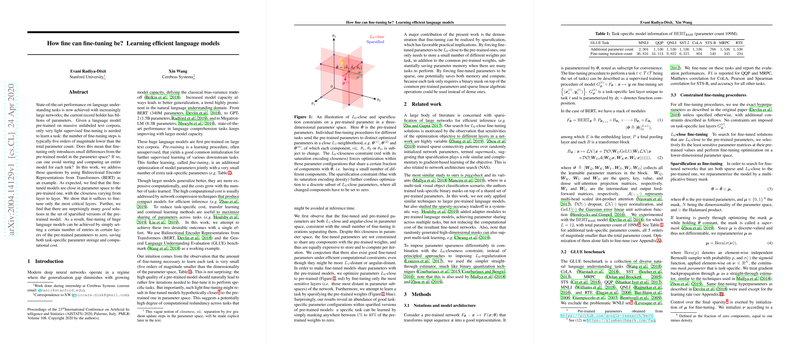Overview of "How fine can fine-tuning be? Learning efficient LLMs"
The paper, titled "How fine can fine-tuning be? Learning efficient LLMs," authored by Evani Radiya-Dixit and Xin Wang, investigates the efficacy and efficiency of fine-tuning pre-trained LLMs, specifically BERT, for various downstream tasks. The research encapsulates the need for efficient computational strategies amid the ever-growing size of state-of-the-art LLMs.
Motivation and Problem Statement
The advent of large-scale LLMs such as BERT, GPT-2, and Megatron-LM has enabled remarkable performance in natural language understanding tasks. These models, pre-trained on vast corpora, achieve task-specific learning via fine-tuning. However, while fine-tuning occurs with computation orders of magnitude smaller than the total number of model parameters, it raises two primary questions:
- Does fine-tuning introduce minute changes in parameter space relative to pre-trained models?
- Can computational costs be reduced by leveraging these minor parameter modifications?
Main Contributions
The paper contributes the following insights and methodologies to address the outlined questions:
- Parameter Closeness: The authors quantify that fine-tuned models remain close in parameter space to pre-trained models, showing minimal and angular distances. This closeness is consistent with the small number of fine-tuning iterations compared to the parameter count.
- Layer Sensitivity: Through empirical analysis, the paper highlights that only specific layers undergo significant changes during fine-tuning, suggesting that fine-tuning can be efficiently achieved by focusing on these critical layers.
- Sparsified Models: The paper reveals that good task-specific performance can be attained by sparsifying a pre-trained model’s weights. Sparse fine-tuning involves setting a certain fraction of weights in selected layers to zero, thereby maintaining performance while reducing computational costs.
Methodology
The paper`s empirical framework focuses on BERT and evaluates results using the General Language Understanding Evaluation (GLUE) benchmark. Several methods were proposed:
- -Close Fine-Tuning: The approach involves fixing the least sensitive parameters, thereby reducing the number of parameters fine-tuned and resulting in models computationally closer to the original pre-trained models.
- Supermask Training: This method uses binary masks to prune the pre-trained model’s parameters selectively. The masks are optimized to find configurations that, despite being sparsified, still perform well on downstream tasks.
Results
The paper provides robust numerical evidence supporting its claims:
- Close Parameter Space: Fine-tuned models exhibited distances in the range of from pre-trained models, and angular distances ranging from , significantly lower than random initializations.
- Efficient Fine-Tuning: By excluding several layers during fine-tuning, up to 40% reduction in task-specific parameter count was achieved with marginal performance degradation.
- Sparse Fine-Tuning Effectiveness: Fine-tuning with up to 40% sparsity in crucial layers incurred slight performance degradation, whereas more aggressive sparsification yielded models with slightly lower but acceptable downstream task performance.
Implications
The implications of this work span both theoretical and practical domains:
- Theoretical Implications: The results suggest that the parameter landscape of pre-trained models contains numerous local optima that are close to the pre-trained configuration but effective for different tasks. This challenges conventional sensitivity assumptions regarding model parameters and opens new directions in model optimization landscapes.
- Practical Implications: From a practical standpoint, the reduction in computational costs and parameter storage makes fine-tuning more sustainable and accessible, facilitating broader deployment of LLMs in resource-constrained environments.
Future Directions
Given the findings, future research could:
- Investigate layer-specific interactions in larger model architectures to identify optimal fine-tuning strategies.
- Explore the implications of sparse fine-tuning across other domains beyond natural language processing, such as computer vision and reinforcement learning.
- Develop more sophisticated mask optimization techniques that can further improve performance or reduce sparsity requirements.
Conclusion
The paper "How fine can fine-tuning be? Learning efficient LLMs" provides significant insights into efficient computational strategies for fine-tuning pre-trained LLMs. By highlighting the feasibility of limited parameter adjustments and the efficacy of sparsification, this research offers valuable contributions to the optimization and deployment of LLMs.
